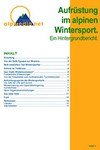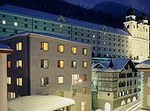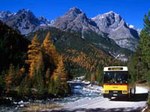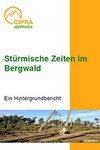Dossiers
Transport in climate change

This CIPRA compact offers an overview on transport projects in the Alps for the reduction and adaptation to climate change. CIPRA shows its main stance on this point: if we do not change our mobility behaviours, climate objectives will not be reached! Truck transport must become more expensive and environmental transport types must be clearly forced. Additional relevant material on the issue can be found in other language versions of this page.
The upgrading of Alpine winter sports

The Dossier is dedicated to the topic of "The upgrading of Alpine winter sports". The background report describes the latest trends in winter sports in the Alps as well as their economic impact. The catchwords include "fun tourism", increased capacities, artificial snow and new developments. One important conclusion: at a time when the number of skiers is decreasing and global warming is increasing, the Alpine tourist resorts which will survive and succeed in preserving their autonomy are those which see nature and the landscape as their most precious asset and which come up with alternatives to one-sided ski tourism. Additional relevant material on the issue can be found in other language versions of this page.
Modern architecture in the Alps

The building methods which have typically been used in Alpine regions have always focused on the needs of the population living there and the necessities of survival. It is therefore an architectural style which has been dictated by the limitations and peculiarities of the regions themselves. The old buildings which are today considered typical or traditional are not the result of informed decisions, but the consequences of necessity. The different settlements, houses, stables, places of worship and outbuildings were built not according to particular architectural styles or personal tastes, but as a consequence of binding criteria and based on a balance which had to be struck. So is there such a thing as a modern architecture in the Alps? Additional relevant material on the issue can be found in other language versions of this page.
Eco-tourism in the Alps

In the Alps there are already many forms of nature-orientated tourism, which, in some of its fundamental objectives, is very much like eco-tourism. While nature-orientated tourism in the Alps has a great deal of potential when it comes to value added and niche appeal, it does not have the growth potential attributed to global eco-tourism. There are, however, signs that nature-orientated tourism will gain in significance in the Alps in the years to come. Current discussions on eco-tourism can provide the impetus for those responsible for tourism policy to give more thought to an overall strategy for nature-orientated tourism in the Alps, together with the key players operating at the grass-roots level. Additional relevant material on the issue can be found in other language versions of this page.
Constructing and refurbishing in climate change

This CIPRA compact offers an overview on building projects in the Alps for the reduction and adaptation to climate change. CIPRA shows its main stance on this point: building renovation is a fundamental contribution to climate protection. In new buildings the passive house standard must be introduced in the Alps. The house of the future will even produce energy! Additional relevant material on the issue can be found in other language versions of this page.
Climate change and the Alps

Globally the 1990s were the warmest decade since reliable instrument recordings began in 1860; they were very possibly also the warmest in the past one thousand years. For the Alpine countries, these latest findings are of particular significance for the hydrosphere, i.e. the hydrological cycle, and the cryosphere, i.e. snow and ice. Future winters will be characterised by less snow and more rain. Even a 1 °C increase in temperature means the average duration of the snow cover in certain regions will be reduced by 4 to 6 weeks. Hope for the future in the climate dilemma rests with municipal energy policies, the greater use of renewable energies, and the promotion of a sustainable economic approach and lifestyle. Additional relevant material on the issue can be found in other language versions of this page.
Stormy times in mountain forests

In the 1990s four storms in the Alpine regions caused quite a stir: in February 1990 Vivian and Wiebke, and in December 1999 Lothar and Martin. What they all had in common was the devastation they caused; what was also remarkable was the short time span between them. The Dossier's background report, which is available only in German, outlines the extent and causes of the damage caused in the forest areas and the way in which the storm areas were addressed depending on the different interests governing the use of those areas. Additional relevant material on the issue can be found in other language versions of this page.
Leisure-related traffic

The background report for the "Mobility and Leisure" Dossier features the latest facts and figures on the subject of leisure-related traffic. What activities act as its driving force? What modes of transport are actually used? How do different countries compare? And what sort of problems does leisure-related mobility entail? The main section features examples of the implementation of sustainable mobility in leisure-related traffic in the Alpine region. The emphasis is on special public transport offers for leisure activities as well as projects for sustainable transport solutions for tourism. In countries such as Switzerland, Austria or Germany leisure-related traffic already accounts for 50 to 60% of the overall traffic volume. In these countries the proportion of private motorised traffic in leisure-related traffic is very high, at around 60% to 80%. That proportion of leisure-related traffic is set to increase in the future. Additional relevant material on the issue can be found in other language versions of this page.
Wind energy in the Alps

For some time now concerns about global warming and all its consequences, due mainly to the CO2 emissions released by the burning of fossil energy forms, have cleared the way for a rethink on fossil fuels. The economic backdrop is also changing. Up until now, renewable energies had little chance of success as long as oil prices were falling. Now, however, renewable energies are becoming less expensive. Leading the way in matters of cost-effectiveness is wind energy. Meanwhile the price of crude oil has reached new highs, and the trend is upwards. Aside from the depletion of natural resources, oil cannot be relied on in future. Additional relevant material on the issue can be found in other language versions of this page.
Hydraulic power in the Alps

Does hydropower deliver green electricity? Hydropower is a renewable source of energy. The use of hydropower is emission-free and has no negative impact on our environment. What's more, large quantities of electricity can be produced relatively cost-effectively. So what more could you ask for? Well, the environmentally-conscious want more. The use of hydropower entails huge hydrological changes and major impacts on waterway systems. Entire eco-systems can be irreversibly damaged as a result. In the Alps in particular, the construction of hydropower stations has in the past destroyed natural and near-natural landscapes. So is electricity from hydropower green or not? Additional relevant material on the issue can be found in other language versions of this page.

